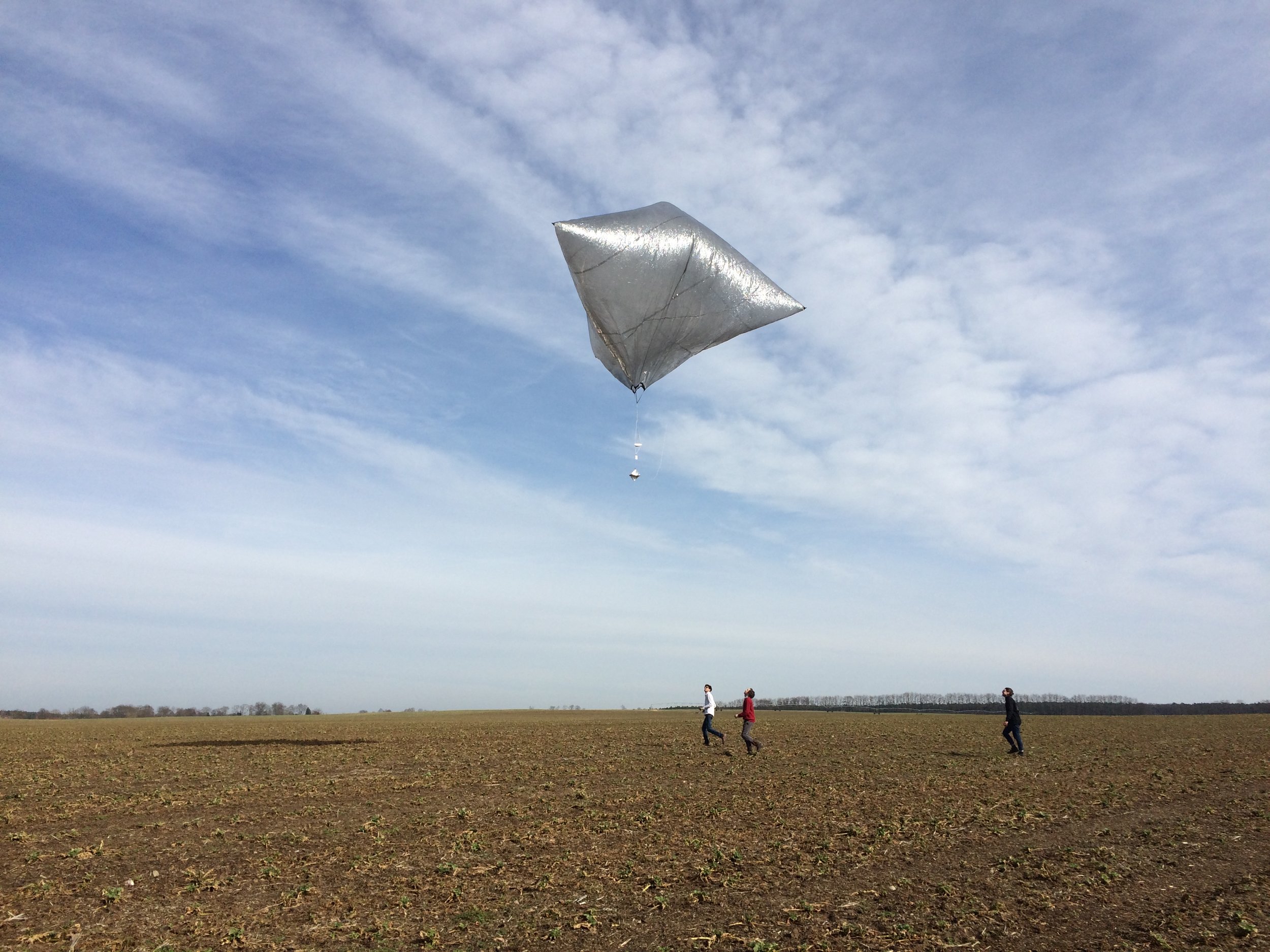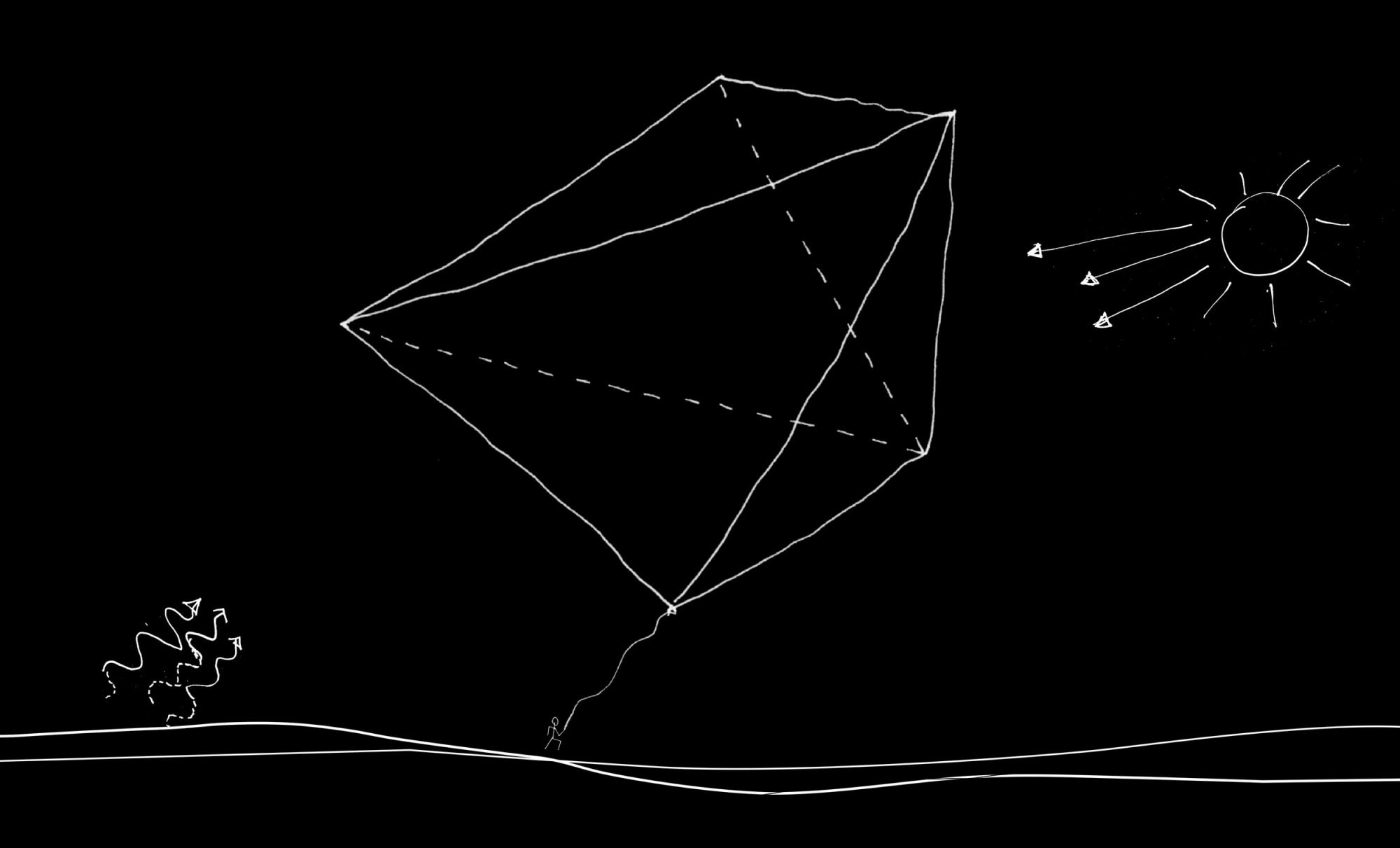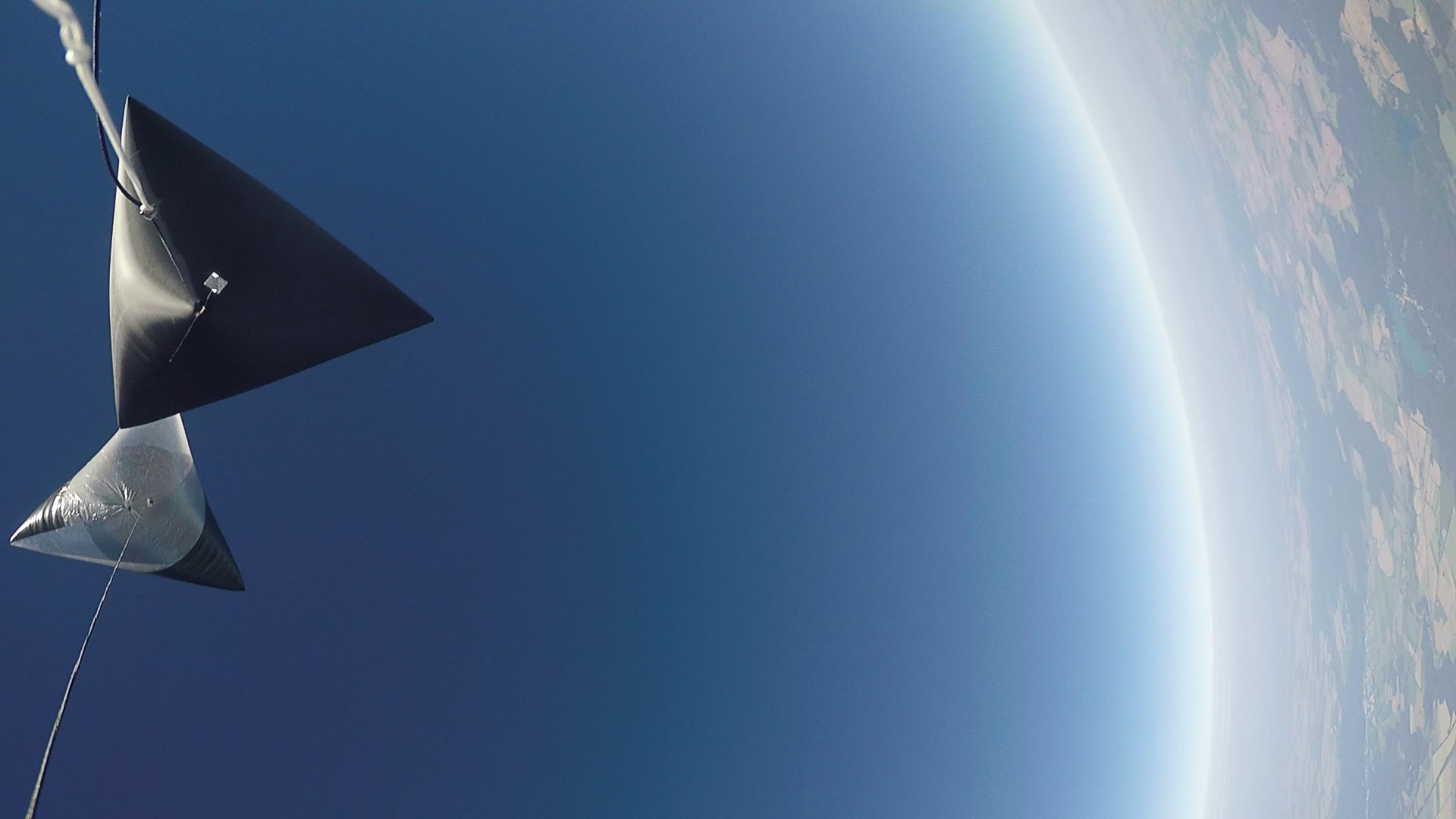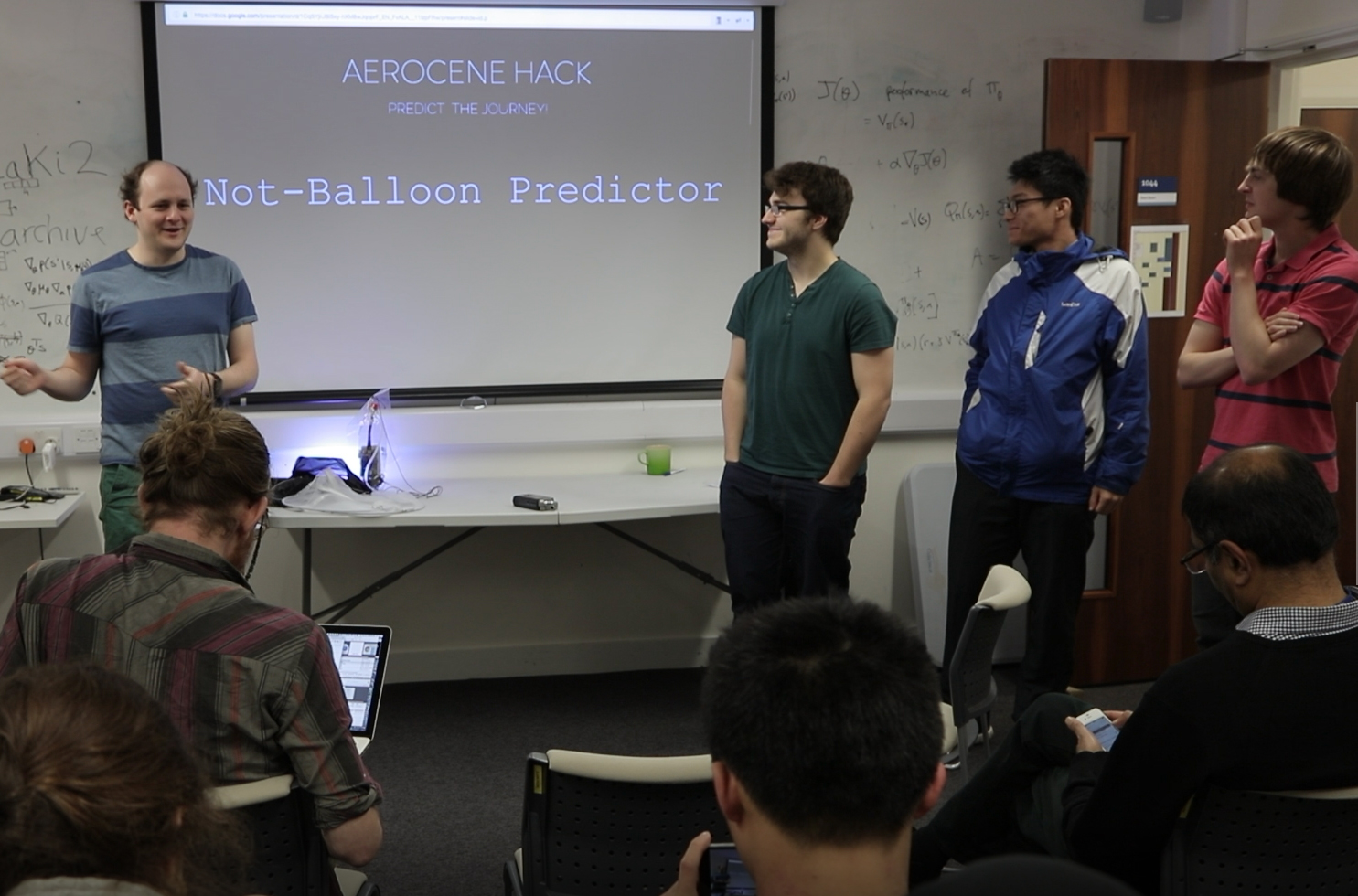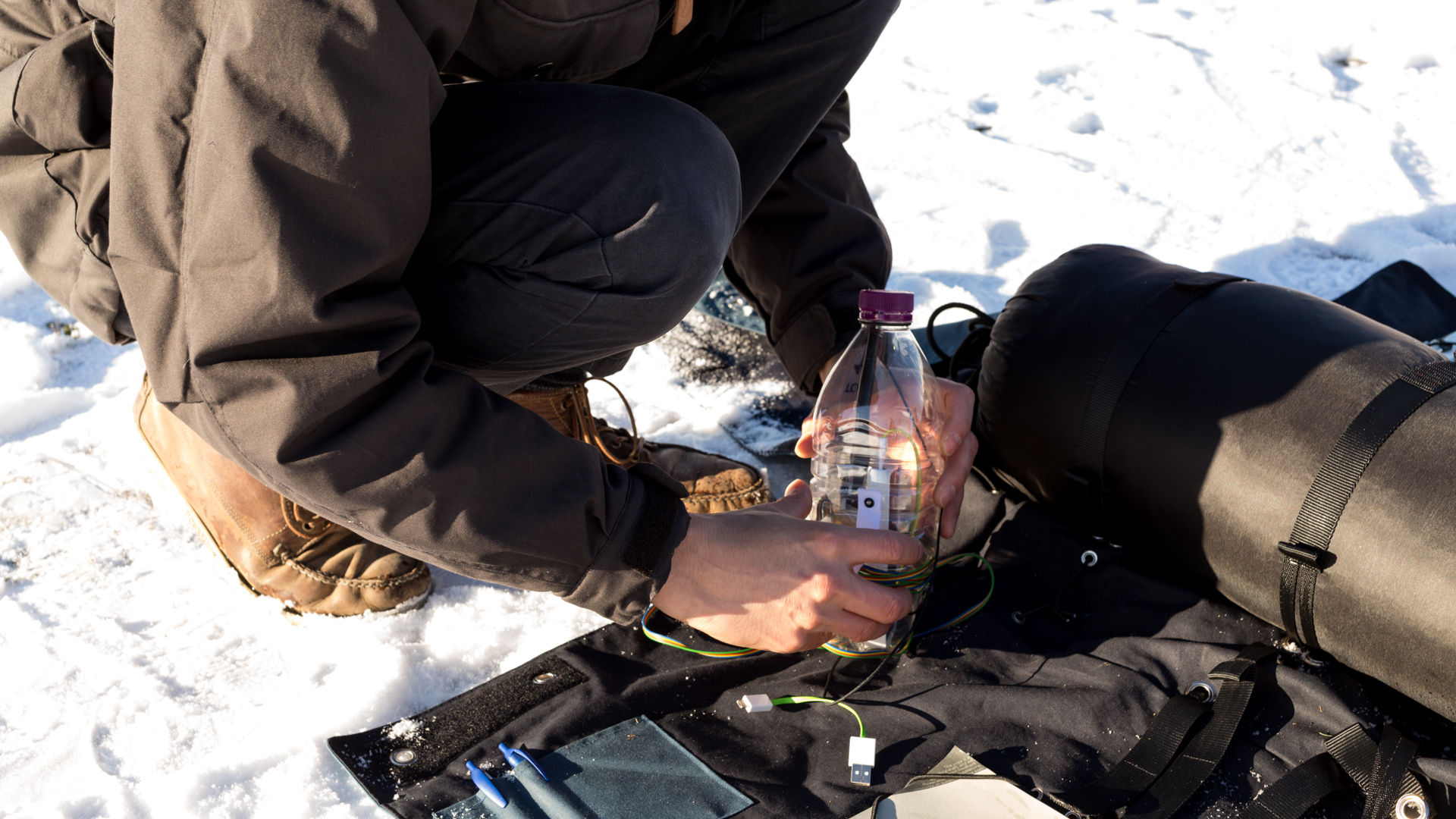On the heels of the groundbreaking Antarctic Biennale expedition, a heterogeneous group of engineers, oceanographers, hacktivists, writers and artists gathered for a productive Aerocene brainstorming session at Satellogic, a tech company building nanosatellites in Buenos Aires.
Continue reading4 March Free Flight Schönfelde, Germany: Launch Report
A surprising outcome on launch day as the Aerocene sculptures Schellin, 51 Pegasi b, and an Explorer Trio all rose into the sky above Schönfelde, Germany. Read the full launch report here >>
Continue readingAerocene Free Flight: In partnership with Wilhelm-Hack-Museum
Scheduled for lift off: a new highly transparent, free-floating aerosolar sculpture!
Continue readingDocumentation: Aerocene Hack 2
Participants of Aerocene Hack 2 – young scientists, designers, and developers – were invited to join the Aerocene Campus symposium before settling into the Imperial College Advanced Hackspace for a productive session of ideation and prototyping of the Aerocene Explorer.
Continue readingAerocene Hack 2, Exhibition Road, London – open call
OPEN CALL:
AEROCENE HACK 2
NOVEMBER 26-27, 2016 | Exhibition road, london
**UPDATE: Aerocene Hack 2 application deadline has been extended until 24 November, 2016 at 23:59 (GMT)**
Aerocene together with Exhibition Road institutions announce an open call for an collaborative hack to imagine and prototype the future of the Aerocene Explorer. We are looking for developers, designers, artists, data scientists, and creative technologists.
Aerocene is an open-source project for artistic and scientific exploration. Originating from the vision of artist Tomás Saraceno, the project centers around the Aerocene Backpack, an evolving air-fuelled sculpture for personal exploration of the air. Becoming buoyant from the heat of the Sun and infrared radiation from the surface of Earth, and carried by the jet streams, Aerocene Explorer aims to achieve a carbon-emissions-free journey around the world. The project is embedded in a community of collaborators and partners from around the world, pushing the development of new solutions and technologies for sustainable Aerocene travel and living. Aerocene is a movement, an invitation to shape a period of time, a new epoch. Aerocene is a response to – and a way to transcend – our current Anthropocene era.
This is the second of a series of hack events taking place as part of Aerocene at Exhibition Road (documentation of the previous hack here). Through October to December 2016, Aerocene is working together with members of the Exhibition Road Cultural Group – 17 prestigious cultural and scientific institutions, among them Imperial College London, the Natural History Museum, the Victoria and Albert Museum, and Serpentine Galleries – to create an open and collaborative research platform.
The Challenges
The Aerocene Backpack, our tethered-flight starter kit currently in beta version, will enable anyone to launch their own personal exploration of the atmosphere. This hack will be about imagining and prototyping future extensions, iterations and supporting tools for the Aerocene Explorer under three specific challenges:
I. FREE FLIGHT (Prediction and Visualisation)
This challenge is about helping future iterations of the Aerocene Explorer, already in development, to fly free by mapping, visualising and predicting Aerocene Explorer flight paths. In a test earlier this summer the free-flying Aerocene “Gemini” traveled from Berlin to northeastern Poland, a distance of 800 km, without burning any fossil fuels! We can offer trajectory data from this and other free-flights, access to a prototype flight predictor based on public NOAA GFS (Global Forecast System) data developed with our collaborators at MIT’s Earth, Atmospheric and Planetary Science Department (EAPS), and the possibility to iterate further on projects developed in the previous Aerocene Hack, 29-30th October. We invite mashups with other data sources, beautiful visualisations, and intuitive user interfaces that imagine new ways to interact with the data.
II. LIFE IN THE AIR
The air above us is more than just empty space. This challenge is about extending the sensing capabilities of the Aerocene Explorer to study airborne ecosystems: microbes, fungal spores, insects… Currently the Aerocene Backpack carries a camera for streaming live aerial footage and a sensors for collecting bariometric pressure, humidity and temperature data. Under guidance of experts from the Natural History Museum, this challenge invites the development of new sensing tools, traps and devices for sensing and sampling aerial biodiversity.
III. AEROCENE SOUNDING
Since the early 1960 balloons have been used to ‘sound’ the atmosphere: communicating atmospheric data at different altitudes and locations through radio. Hundreds of radiosonde balloons are launched around the world daily for atmospheric research and to monitor weather systems. Similarly, radio communications have been crucial for Aerocene Explorer test free-flights for tracking, recovery and data retrieval. This challenge is about exploring the technical, scientific and artistic potential of sounding and radio communication with the Aerocene Explorer: from mesh communications, to data science and atmospheric fluid dynamics, visualisation and sonification of data, infra-sound and aero-acoustics.
What to expect
The hack will run over the weekend 26-27th November. It will begin on Saturday morning with an introduction to the project and challenges, and initial brainstorming as part of the Aerocene Campus event at the Royal College of Art Senior Common Room. After lunch the hack will move to the Imperial College Advanced Hackspace (ICAH) to refine project ideas, form interdisciplinary teams and begin prototyping hacks. Expert guidance, feedback and help will be provided. We will provide food, drinks, tools and equipment, hardware and basic prototyping materials.
In the spirit of open source all teams will be encouraged to openly document their progress and share their final documentation. Teams will automatically become part of the Aerocene community.
Time frame
24/11 – application deadline (23:59 GMT)
25/11 – notification of selected participants
26/11 9:30AM – kick-off as part of Aerocene Campus
26/11 14:00PM – 27/11 18:00PM – hack continues at Imperial College Advanced Hackspace
How to Apply
Sign up below and tell us why you should be part of the Aerocene Open Call. You will be notified on November 25th whether you have been accepted to join the project
About Aerocene
Floating without burning fossil fuels, without using solar panels or batteries, and without helium, hydrogen, or other rare gases, the Aerocene sculptures hold a message of simplicity, creativity, and cooperation in a world of tumultuous geopolitical relations, reminding us of our symbiotic relationship with the Earth and all of its species. Tomás Saraceno holds the certified world record for the first and longest, fully solar-powered, tethered solar balloon flight. This record was achieved on 8 November 2015 in the White Sands desert, New Mexico, a site of geographical significance as the missile range where the first atomic bomb test was conducted.
Aerocene is comprised of a dedicated and diverse global community of artists, geographers, philosophers, thinkers, speculative scientists, explorers, balloonists, technologists, and more. The first public presentation of the project under the name of Aerocene was at COP21, the United Nations Climate Change Conference, at the Grand Palais, Paris in 2015. The Aerocene project’s primary collaborators and supporters are the Center for Art, Science & Technology (CAST) at the Massachusetts Institute of Technology (MIT), CNES (French National Space Agency), CCK Argentina, Public Lab, The Goethe Institute, Radioamateur, Freifunk, IAK architecture-related Art Institute at Technische Universität Braunschweig, and TBA21, among others. Aerocene transcends boundaries between art and science and has become a visionary open participatory platform of knowledge production and distribution.
About Tomás Saraceno
Tomás Saraceno’s oeuvre could be seen as an ongoing research, informed by the worlds of art, architecture, natural sciences and engineering; his floating sculptures and interactive installations propose and explore new, sustainable ways of inhabiting and sensing the environment. Saraceno has, for the first time, scanned, reconstructed and reimagined spiders’ woven spatial habitats, in a unique artistic and bioacoustics experience that uses groundbreaking methods and is expanding the horizons of scientific research. He possesses the first and biggest three-dimensional spider web collection, the natural science object that has been overlooked by museums and research institutions. He has initiated many collaborations with renowned scientific institutions, including the Massachusetts Institute of Technology (MIT) and Max Planck Institute. Saraceno also achieved the world record of the first and longest certified fully solar flight, lifting a dozen of people in White Sands desert with D-O AEC sculpture without a drop of fuel, without solar panels or batteries, and without any artificially produced gases. His work has been exhibited internationally.
Aerocene’s residency at the Goethe-Institut London as part of the Exhibition Road Commission has been made possible thanks to the support of members of the Exhibition Road Cultural Group, Arts Council England, South Kensington Estates and our Founding Patrons: Francesca von Habsburg, Maja Hoffmann and Nicoletta Fiorucci.
Aerocene at Exhibition Road
Aerocene at Exhibition Road, London
Through October to December 2016, Aerocene comes to the Exhibition Road for an interdisciplinary artistic project co-produced by the members of the Exhibition Road Cultural Group, gathering together 16 prestigious cultural and scientific institutions in London, among them the The Serpentine Galleries, Imperial College London, The Natural History Museum, and The Royal College of Art. For this occasion, Aerocene creates an collaborative research platform between Exhibition Road members and wider communities.
“Aerocene is to imagine a metabolic and thermodynamic transformation of human societies’ relation with both the Earth and the Sun. It is an invitation to think of new ways to move and sense and live with the circulation of energy. And, it is a scalable process to repattern atmospheric dwelling and politics through open source ecology of practices, models, data and sensitivity to the more than human world. The Aerocene proposes airborne cities floating among clouds, just as the Earth floats in the cosmic plane.” Adaptation from Saraceno, Engelmann and Szerszynski, (2015: 59).*
Programme
26th November
Aerocene Campus
http://aerocene.org/aerocene-campus
26th-27th November
Aerocene HACK 2 – open call
http://aerocene.org/aerocene-hack2
29-30th October
Aerocene HACK – open call
http://aerocene.org/aerocene-open-call-exhibition-road
28th October
Aerocene at the Natural History Museum Lates
http://www.nhm.ac.uk/visit/whats-on/programs/nhm/discovery_lates.html?date=28.10.2016
8-10th October
Serpentine Miracle Marathon
http://radio.serpentinegalleries.org/2016/10/04/tomas-saraceno/
An invitation to explore the Aerocene Epoch / Hacking the Aerocene Explorer at Exhibition Road
The air is full of species that have helped ecologists understand and detect the climatic changes we see today. Through diverse investigations in aerial life, Aerocene inspires novel inquiries, collaborations and data sets animated by sharing across artistic and scientific practices.
Here we share the topics and ideas that have arisen through conversations with pioneering experts in the field: we get to know the people who will speculate the possibilities of Aerocene research, and make relevant contributions to debates on metabolic and environmental futures.
The practices of recording and monitoring life in the air are faced with significant challenges in physical limitations of technology and scientific sampling. With Aerocene Explorer’s unique possibilities, the trajectories of sampling journeys could be traced with flight predictors at a variety of previously unreachable locations via emission-free journeys.
Areocene on new methods of sampling techniques to support the study of diversity in the air
AEROCENE AND COSMIC DUST
One of the oldest collections in the world, the Natural History Museum holds almost 5,000 specimens, many of which were seen to fall to Earth. Such objects have incredibly unusual and interesting patterns that convey the forces they underwent on their asteroid parent body,while passing through space and on entering our atmosphere. The class of extraterrestrial material known as “micrometeorites” offers the opportunity to study “Cosmic Dust” as such matter falls on Earth in an immense quantity each day. Equipped with proper capturing devices, Aerocene sculptures could be employed as collectors of such cosmic material. Such research could lead towards questions not only about Life in the Air, but Life in the Cosmos, placing human and Earth-bound endeavours in a much larger cosmic scale. Aerocene’s possible collaboration with collecting meteoritic material came about through a conversation with Natasha Almeida, Assistant Curator ofMeteorites at the Natural History Museum.
AEROCENE AND SAMPLING OF AIRBORNE LICHEN FORMING FUNGI
How quickly can we expect the re-colonisation of the rainforest? This remarkable and yet unanswered question is put forward through a discussion between Aerocene & the Natural History Museum. Through sampling and recording lichens in the Borneo air, the Aerocene Explorer could help to predict the chances and times scales of the recovery of the Borneo rainforest. With uncertainties in the long term role of palm oil plantations in SE Asian economies, and the possibility of changing land uses, our ongoing conversations unpacked the thinking around Areocene Explorer’s first lichen sampling mission to monitor the air above the island of Borneo. This idea emerged in conversation with scientists at the LS Division of Diversity and Informatics, Natural History Museum.
AEROCENE AND BIOSTRATIGRAPHY, POLLEN
Aerocene is speculating on what kinds of questions might we ask of the principles of biostratigraphy and the associated study of microfossils in order to understand (and in turn, create) more equitable and sustainable futures. In other words, what are the traces in the fossil record that have the potential to create the narratives and imaginaries of alternative futures – those that shift our planet out of the Anthropocene and into the Aerocene? In considering Exhibition Road as a location with a long and complex natural and anthropogenic history, Aerocene is developing further research on the biota that inhabit the Road – especially the London Plane Trees whose pollen grains are rather small (20-30 microns in diameter) and under-studied yet who tower above visitors of the Natural History Museum. Taking cues from pollen and spores, Aerocene is interested in the factors of materiality and morphology that are most ideal for floating in space. Many of these trajectories emerged in a conversation with Dr. Thomas Hill, a micropalaeontologist who specialises in the analysis of Quaternary sedimentary archives in order to reconstruct past environmental conditions. He undertakes the application of diatom and pollen analysis to sedimentary sequences in order to reconstruct past sea level and vegetation change.
AEROCENE AND THE GEOHUMANITIES
What is the meaning of geographical exploration today? How can exploratory journeys become sensitive to the physical and spatial as well as humanistic and creative expressions of our planet and its cultures? In the context of these questions, Aerocene finds resonances with the important new momentum toward GeoHumanities scholarship and research in human and cultural geography. There are specific invitations to working across disciplinary and practice-oriented fields embedded in the Aerocene and articulated in the GeoHumanities. The Aerocene residency period on Exhibition Road is an opportunity to test and intensify these qualities in the project, especially to the extent that they can foster new communities, publics and politics on Exhibition Road and beyond. The interstices between Aerocene and GeoHumanities discourse were fostered by an exciting working session with Dr. Harriet Hawkins, Co-Director of the Centre for GeoHumanities at Royal Holloway University.
AEROCENE AND THE WORLDWIDE SAMPLING OF MICROBES
Aerocene is inspired to create a campaign for the worldwide engagement of citizens to simultaneously sample microbes in the air. In such an event, dozens of fossil-fuel-free Aerocene Explorers could be launched at various sites across the planet by communities and residents at a specific moment in time. Through eDNA assessments and sequencing technologies, Aerocene Explorers’ cumulative samples, connected by space, environmental parameters, and citizens of the world, could provide fundamental insights into microbial diversity in the air on a previously unattainable global scale. This speculative campaign evolved through a rich conversation with Dr Anne Jungblut, Researcher, Life Sciences Department, LS Division of Diversity and Informatics, Natural History Museum.
This is a live stream feed of information: it is continually being updated in reaction to every conversation we have with each researcher, so please check back to see more experts added to the list.
Aerocene Intervention, Lates at the Natural History Museum
Aerocene at the Attenborough Studio exploring and discussing more about the project.
Aerocene HACK…begins!
Aercocene has been working with developers, designers, artists, data scientists and creative technologists from Imperial College London and the Royal College of Art. Participants imagined and prototyped innovative user scenarios for Aerocene flights, including mashups with other data sources.
And more to be announced!
Do you have an idea for the Aerocene community? Help us shape our Aerocene future together! Anyone can take part and actively contribute to our research to help us find out what we know about life in the air — and what we don’t know — with your own ideas and imagination! Click here to start brainstorming with us.
—
*The ideas and text in this passage come from the exchange between Bronislaw Szerszynski, Sasha Engelmann and Tomás Saraceno in: Saraceno, T., Engelmann, S., and Szerszynski, B. (2015). Becoming Aerosolar: Solar Sculptures to Cloud Cities in H. Davis and E. Turpin (Eds.), Art in the Anthropocene: Encounters Among Aesthetics, Politics, Environments and Epistemologies (pp. 57-62). London: Open Humanities Press.
Aerocene’s residency at the Goethe-Institut London as part of the Exhibition Road Commission has been made possible thanks to the support of members of the Exhibition Road Cultural Group, Arts Council England, South Kensington Estates and our Founding Patrons: Francesca von Habsburg, Maja Hoffmann and Nicoletta Fiorucci.
Open Call: AEROCENE HACK 2
Aerocene together with Exhibition Road institutions announce an open call for a second collaborative hack to imagine and prototype the future of the Aerocene Explorer. We are looking for developers, designers, artists, data scientists, and creative technologists. Aerocene is an open-source project for artistic and scientific exploration which centers around the Aerocene Explorer, an evolving air-fuelled sculpture for personal exploration of the air.
Aerocene Campus
How can we hack the Anthropocene to create the Aerocene? The first Aerocene Campus is an open invitation to explore, extend and imagine the Aerocene Epoch through the sculpture of the Aerocene Explorer. The Campus asks how community-driven practices with the Aerocene Explorer can inform environmental, social and mental ecologies in post-Anthropocenic worlds.
Continue readingHacking Aerocene flight prediction: CUSF at the Aerocene Hack
Aerocene has long been a big fan of the flight prediction tool predict.habhub.org, developed by Cambridge University Spaceflight. We were happy to have CSF’s Adam Greig, Daniel Richman and Jamie Wood join our latest Hack at the Imperial College Advanced Hackspace in London.
Continue reading
Documentation: Aerocene Hack
Young scientists, designers, developers, and artists joined Aerocene in the Imperial College Advanced Hackspace for a two-day period of intense collaboration to hack the Aerocene Explorer – grappling with code, electronics, and the vast possibilities of Aerocene exploration.
Continue reading
